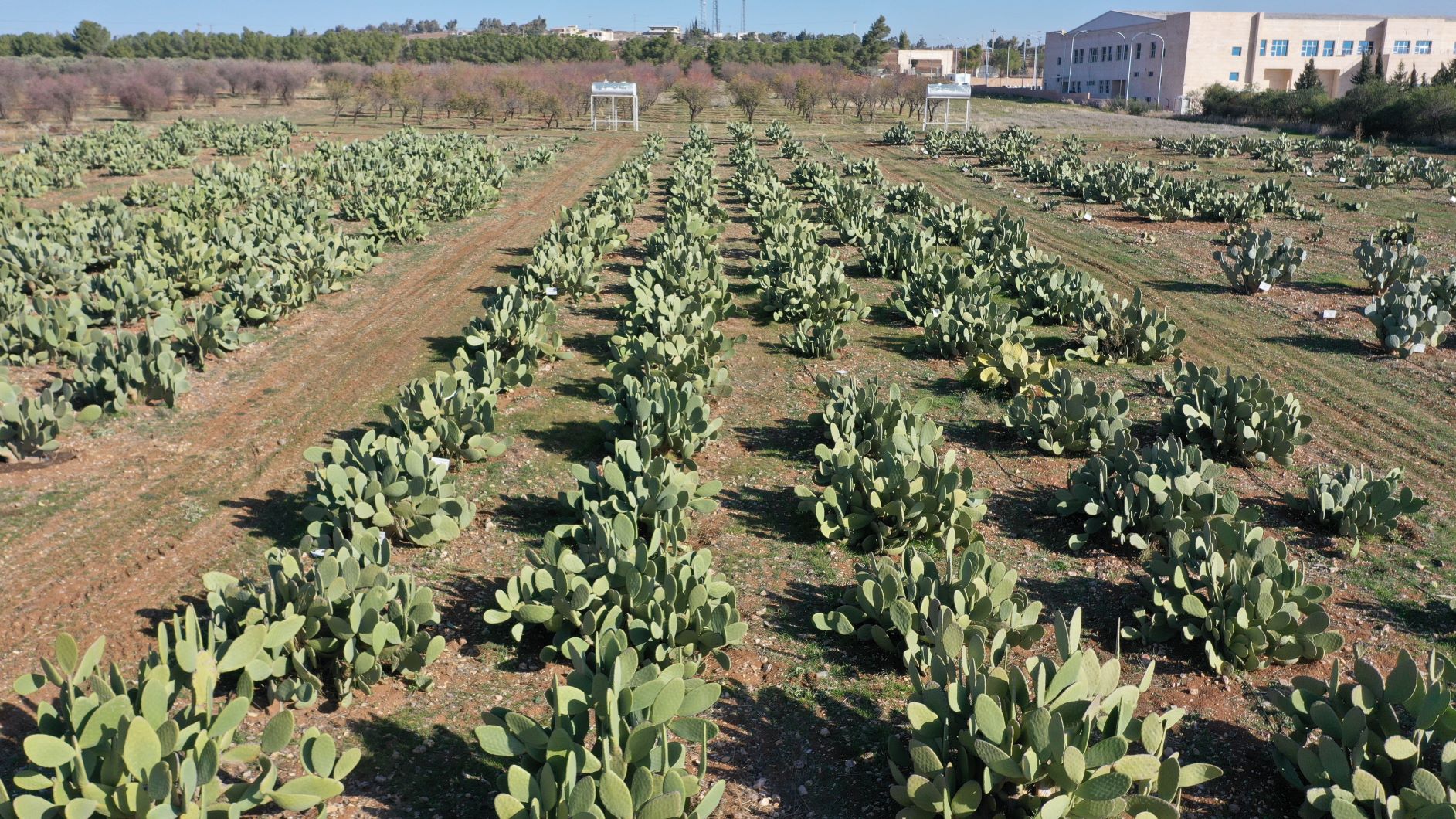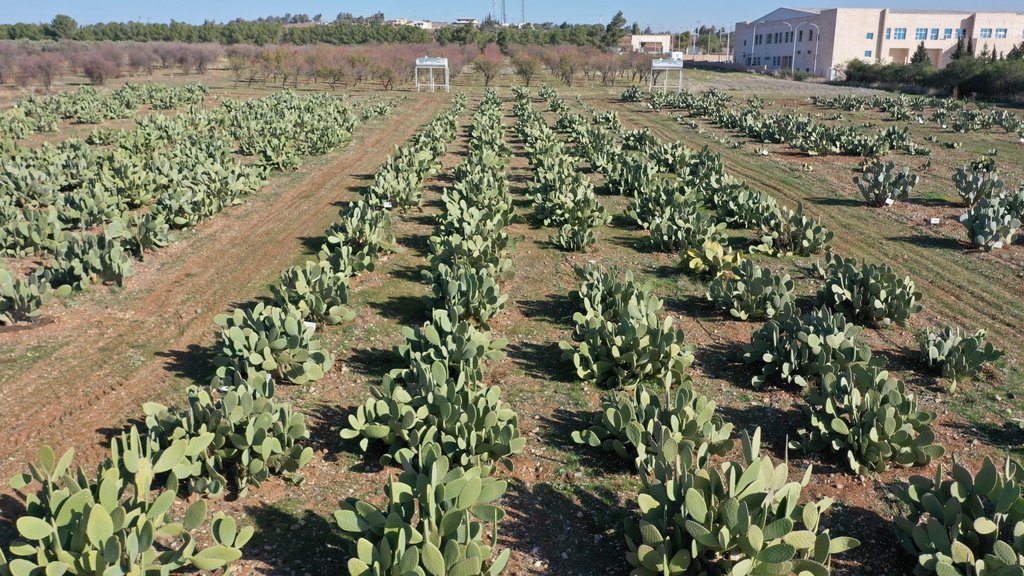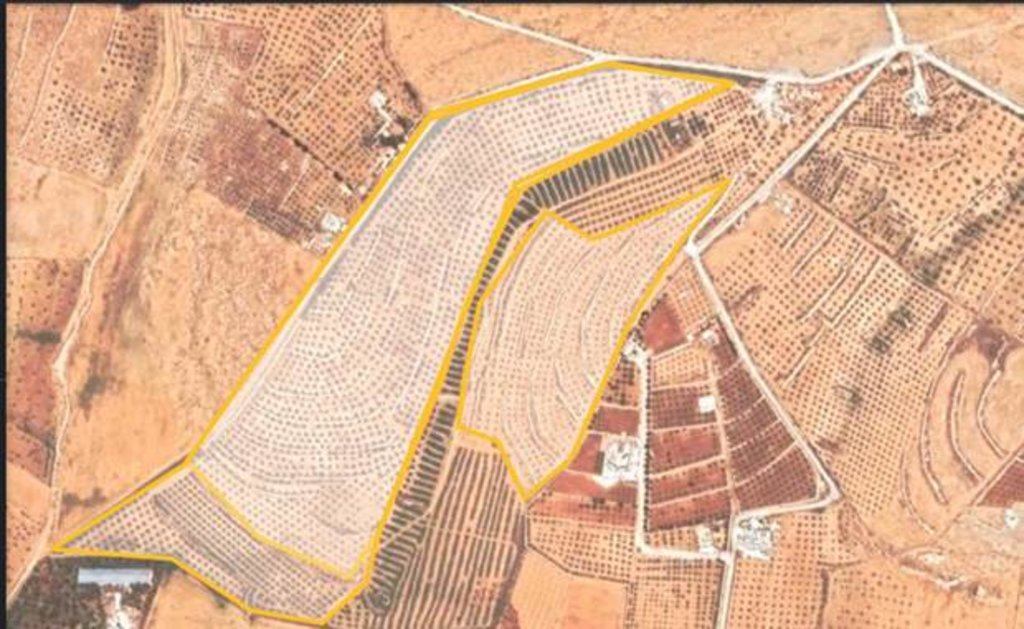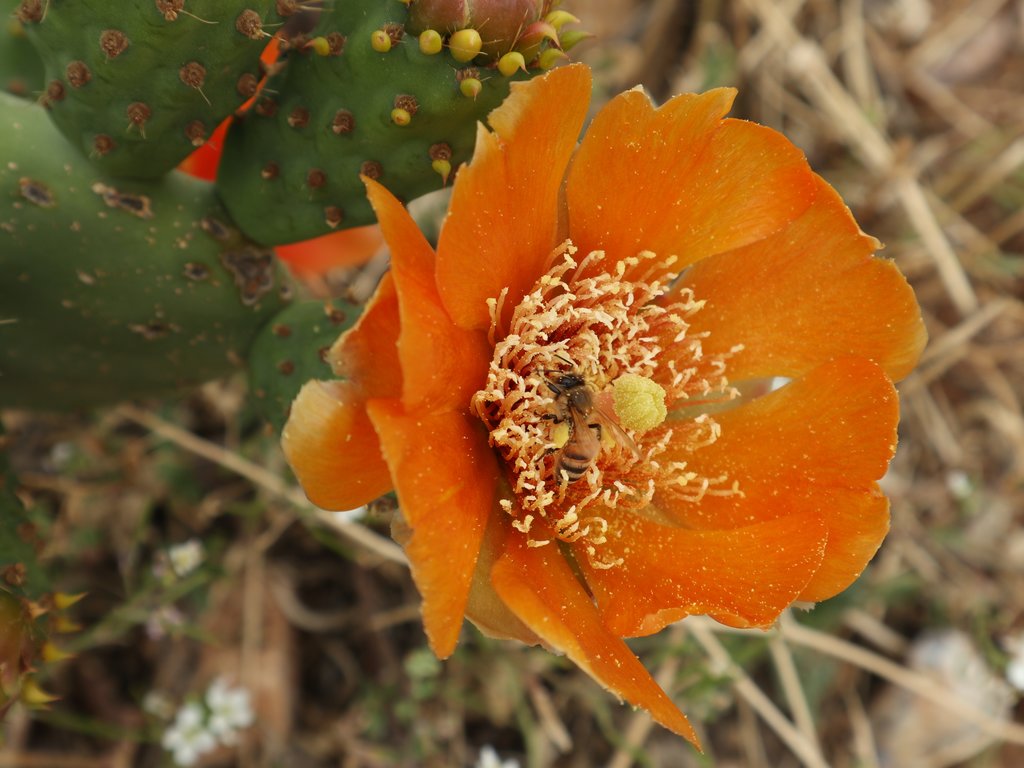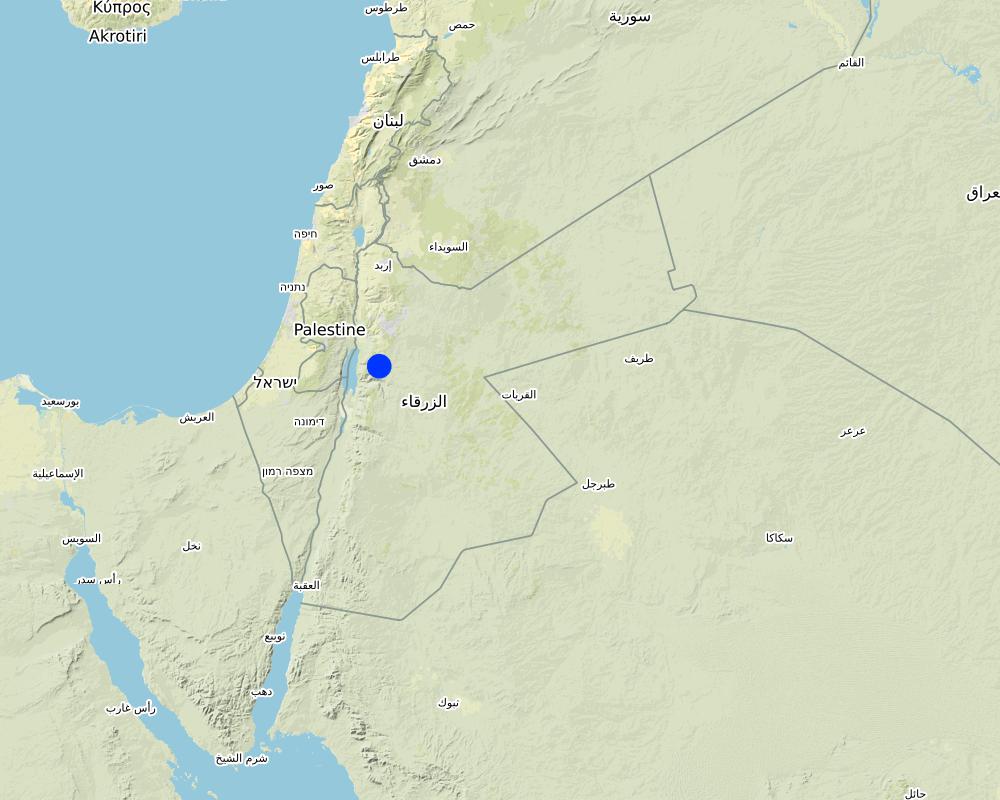Cactus Fruit Plantation in Arid Dry Lands [约旦]
- 创建:
- 更新:
- 编制者: Joren Verbist
- 编辑者: –
- 审查者: Rima Mekdaschi Studer
technologies_5847 - 约旦
查看章节
全部展开 全部收起1. 一般信息
1.2 参与该技术评估和文件编制的资源人员和机构的联系方式
关键资源人
Research Team Leader of Rangeland Ecology and Forages:
Louhaichi Mounir
International Center of Agriculture Research in the Dry Areas (ICARDA)
约旦
Research Associate Coordinator of Forage Systems:
Hassan Sawsan
International Center of Agriculture Research in the Dry Areas (ICARDA)
约旦
有助于对技术进行记录/评估的项目名称(如相关)
ICARDA Institutional Knowledge Management Initiative有助于对技术进行记录/评估的机构名称(如相关)
International Center for Agricultural Research in the Dry Areas (ICARDA) - 黎巴嫩1.3 关于使用通过WOCAT记录的数据的条件
编制者和关键资源人员接受有关使用通过WOCAT记录数据的条件。:
是
1.4 所述技术的可持续性声明
这里所描述的技术在土地退化方面是否存在问题,导致无法被认为是一种可持续的土地管理技术?:
否
2. SLM技术的说明
2.1 技术简介
技术定义:
This technology is based on the natural advantages and the multi-purpose usage of spineless cactus pear (Opuntia fiscus-indica), to cultivate marginal lands in Jordan, generating environmental and socio-economic benefits.
2.2 技术的详细说明
说明:
In the arid parts of Jordan with limited rainfall, little irrigation, high water evaporation, poor soil quality and unsustainable land management result in land degradation (erosion and salinization) and productivity loss. Therefore, the International Center Agricultural Research in the Dry Areas (ICARDA) and National Agricultural Research Centre of Jordan (NARC) organized field days (started in 2014) to disseminate knowledge regarding the cultivation of the cactus pear, Opuntia ficus-indica, cactus crop. Cacti can cope with high temperatures and grow well in (semi)-arid areas with 250-600mm annual rainfall or where irrigation is available. Additionally, the plant is very resilient as it can withstand a long dry season due to its high water-content and water-use -efficiency, which are a result of its morphology (waxy cuticle, no actual leaves) and the Crassulacean Acid Metabolism (CAM). In CAM plant, stomata in the leaves remain shut during the day to reduce evapotranspiration, but open at night to collect and fix carbon dioxide (CO2). In general, cacti have multiple products that benefit local livelihoods, these are for example stable production of fodder for livestock and fruits for human consumption. Also, cactus can grow and produce requiring few inputs such as fertilizers, therefore marginal lands are well suited for cactus cultivation.
The market for cactus fruits is very promising in Jordan. Nowadays, there is high demand for cactus fruits as people grow fond of the fruits but also for medicinal uses. This documentation is focused on a farm covering roughly 10 hectares, where cactus was planted due to its socio-economic and environmental advantages i.e. the high prices for cactus fruits and the ability of cactus to grow in marginal lands with little input and cover the soil hence preventing soil erosion. However, the farm is not located ideally for cactus cultivation. Therefore, the farm is currently intensively managed in terms of fertilizer application and the irrigation. The previous land use was poor cultivation of barley to feed (grazing) sheep and goats. This led to little soil cover resulting in land degradation in the form of erosion. The farmer paid for the establishment of the cactus-plantation. The cacti are spaced by 4 meters between plants and 3 meters between rows. This spacing is specific for fruit production, in case of fodder production a higher crop density is recommended. The cacti are planted on the contours in pits (40 centimetres depth and diameter) to ensure rain-water collection and efficient fertilizer application as the farm is situated on a 15% slope. The cacti reduce erosion as the roots hold the soil together. Field preparation for the establishment of the cactus field includes: (1) soil scrapping; (2) deep soil ploughing; (3) surface soil ploughing; and (4) pit digging. No fertilizer was applied in the establishment stage. Recurrent activities and costs are weeding, applying fertilizer and organic manure, maintaining the pits and harvesting. 200 kilograms per hectare of inorganic fertilizer (NPK) is applied between March and May. A total of 4 tons per hectare of organic manure is applied in September-November. These activities are non-mechanized, and therefore labour intensive.
The farm receives less than 200mm of annual rainfall and a public dam for irrigation is available. Therefore, the farmer invests in three water tanks to store water brought from the dam using his own truck, and in a drip irrigation system for high irrigation efficiency. The farm is irrigated by 360 cubic meter per month, divided in three events. The costs per cubic meter is 0.95 Jordanian Dinar (JOD) (including transportation costs). Before the realization of the drip irrigation system, the cacti were watered by hand (19991-2015). During the initial three years, cacti produce no fruits making the short-term return on investment rather negative. Currently, the cactus-plantation produces 32.5 ton/ha, equivalent to 65 kg /plant. The average net income per hectare varies between 1650 JOD to 2750 JOD. This makes the farmer relatively medium- wealthy with respect to the area. Most costs are induced by labour as the farmer uses manual weeding, harvesting and fertilizer application.
Even though the cultivation of cacti for its fruits on marginal lands has many benefits like the reduction in erosion, stable production, high output/input efficiency and good prices. There are some weaknesses, for example the relative young market of cactus products in Jordan compared to Tunisia. The Tunisian market for cactus products has a longer history, a high demand for other cactus-products like oil and juice and a better infrastructure (e.g. processing units) exist. These create more consistent prices for farmers, so less price drops during harvesting periods. Another weak point is the fact that cacti are cultivated in mono-culture. This significantly increases the risk of new pests and potential damage of the cultivated crop.
To conclude, this documentation shows that even though the selected farm does not represent an ideal site for cactus pear cultivation, the implementation of cacti is socio-economically and environmentally appropriate to cultivate dry marginal lands as cacti uses water and nutrients highly efficient while reducing land degradation. Therefore, the out-scaling of cacti is very valuable and a practical option to fight land degradation and enhance smallholder’s income.
2.3 技术照片
2.5 已应用该技术的、本评估所涵盖的国家/地区/地点
国家:
约旦
具体说明该技术的分布:
- 均匀地分布在一个区域
如果技术均匀分布在一个区域,则指定覆盖的区域(单位为平方千米):
0.09
如果不知道精确的区域,请注明大致覆盖的区域:
- < 0.1 平方千米(10 公顷)
技术现场是否位于永久保护区?:
否
Map
×2.6 实施日期
注明实施年份:
2014
2.7 技术介绍
详细说明该技术是如何引入的:
- 在实验/研究期间
- 通过项目/外部干预
3. SLM技术的分类
3.1 该技术的主要目的
- 改良生产
- 减少、预防、恢复土地退化
- 适应气候变化/极端天气及其影响
- 创造有益的经济影响
- 创造有益的社会影响
3.2 应用该技术的当前土地利用类型
同一土地单元内混合使用的土地::
否

农田
- 乔木与灌木的种植
乔木和灌木种植 - 指定作物:
- cactus, cactus-like (e.g. opuntia)
采用间作制度了吗?:
否
采用轮作制度了吗?:
否
3.3 由于技术的实施,土地使用是否发生了变化?
由于技术的实施,土地使用是否发生了变化?:
- 是(请在技术实施前填写以下有关土地利用的问题)
同一土地单元内混合使用的土地::
是
具体说明混合土地使用(作物/放牧/树木):
- 农牧业(包括农牧结合)

农田
- 一年一作
年作 - 具体指明作物:
- 谷类 - 大麦
采用间作制度了吗?:
否
采用轮作制度了吗?:
否

牧场
粗放式放牧:
- 半游牧畜牧业
动物类型:
- 山羊
- 绵羊
是否实行作物与牲畜的综合管理?:
否
产品和服务:
- 肉类
- 奶类
3.4 供水
该技术所应用土地的供水:
- 充分灌溉
注释:
360m^3 of water applied through drip irrigation. The annual precipitation is less than 200mm
3.5 该技术所属的SLM组
- 改良的地面/植被覆盖
- 灌溉管理(包括供水、排水)
3.6 包含该技术的可持续土地管理措施

植物措施
- V1:乔木和灌木覆盖层

结构措施
- S7:集水/供水/灌溉设备

管理措施
- M1:改变土地使用类型
3.7 该技术强调的主要土地退化类型

土壤水蚀
- Wt:表土流失/地表侵蚀

土壤风蚀
- Et:表土流失

化学性土壤退化
- Cs:盐化/碱化

物理性土壤退化
- Pk:熟化和结壳

生物性退化
- Bc:植被覆盖的减少
- Bq:数量/生物量减少
3.8 防止、减少或恢复土地退化
具体数量名该技术与土地退化有关的目标:
- 防止土地退化
- 减少土地退化
4. 技术规范、实施活动、投入和成本
4.1 该技术的技术图纸
技术规范(与技术图纸相关):
The rows are placed 3 meters apart (A), and are located on the contour for rainwater collection as the farm field has a slope of 15% (E). The interspace is 4 meters (D). The cacti are planted in pits that have a diameter of roughly 40 centimeters (C) and a depth of 40 centimeters (B).
作者:
Meike Kleinlugtenbeld & Joren Verbist
日期:
20/12/2020
4.2 有关投入和成本计算的一般信息
具体说明成本和投入是如何计算的:
- 每个技术区域
注明尺寸和面积单位:
9.1 hectare
其它/国家货币(具体说明):
JOD
如相关,注明美元与当地货币的汇率(例如1美元=79.9巴西雷亚尔):1美元=:
0.71
注明雇用劳工的每日平均工资成本:
20
4.3 技术建立活动
| 活动 | 时间(季度) | |
|---|---|---|
| 1. | Soil scrapping | Prior to planting |
| 2. | Deep soil ploughing | Prior to planting |
| 3. | Surface soil ploughing | Prior to planting |
| 4. | Pit digging | Prior to planting |
| 5. | Planting cacti | Last third of the dry season (August - October) |
| 6. | Establishment of drip irrigation | If feasible (This case 2015) |
注释:
Drip irrigation can be establishment when feasible (e.g. funds available). It would greatly enhance cactus-production but cacti can survive and produce without it.
4.4 技术建立所需要的费用和投入
| 对投入进行具体说明 | 单位 | 数量 | 单位成本 | 每项投入的总成本 | 土地使用者承担的成本% | |
|---|---|---|---|---|---|---|
| 劳动力 | Pit Digging & Planting | Person Hour | 47.0 | 100.0 | 4700.0 | 100.0 |
| 劳动力 | 100.0 | |||||
| 劳动力 | 100.0 | |||||
| 设备 | Soil Scrapping (Jackhammer) | Machine-Hour | 35.0 | 200.0 | 7000.0 | 100.0 |
| 设备 | Deep Soil Ploughing (Tractor) | Machine-Hour | 9.0 | 250.0 | 2250.0 | 100.0 |
| 设备 | Surface Soil Ploughing | Machine-Hour | 9.0 | 250.0 | 2250.0 | 100.0 |
| 植物材料 | Cactus Pads | Pad | 5000.0 | 0.1 | 500.0 | 100.0 |
| 施工材料 | Drip Irrigation (including labour for installation: 14 person days) | Whole System | 1.0 | 13700.0 | 13700.0 | 100.0 |
| 施工材料 | Water Tanks (including labour for construction: 10 person days) | Tank | 3.0 | 500.0 | 1500.0 | 100.0 |
| 技术建立所需总成本 | 31900.0 | |||||
| 技术建立总成本,美元 | 44929.58 | |||||
注释:
The cacti are planted in pits. The digging of pits and planting of the cactus pads into the pits is done simultaneously, hence this is grouped in terms of labour. For soil preparation (scrapping and ploughing), the costs of labour are included in the machine costs as this was a hired service. The installation of the irrigation system and the construction of the tanks was each offered as a package and hence include the costs of labour.
4.5 维护/经常性活动
| 活动 | 时间/频率 | |
|---|---|---|
| 1. | NPK Fertilizer (1x) | March - May |
| 2. | NPK Fertilizer (1x) | September - November |
| 3. | NPK Fertilizer (1x) | December - February |
| 4. | Organic Manure Application | September - November |
| 5. | Manual Weeding (2x) | March - May |
| 6. | Maintenance of planting pits | April |
| 7. | Harvesting | August - September |
4.6 维护/经常性活动所需要的费用和投入(每年)
| 对投入进行具体说明 | 单位 | 数量 | 单位成本 | 每项投入的总成本 | 土地使用者承担的成本% | |
|---|---|---|---|---|---|---|
| 劳动力 | NPK Fertilizer Application | Person-Day | 9.0 | 20.0 | 180.0 | 100.0 |
| 劳动力 | Organic Manure Application | Person-Day | 7.0 | 20.0 | 140.0 | 100.0 |
| 劳动力 | Total Weeding | Person-Day | 200.0 | 15.0 | 3000.0 | 100.0 |
| 劳动力 | Harvesting / Fruit Grabbing | Person-Day | 280.0 | 20.0 | 5600.0 | 100.0 |
| 设备 | Irrigation Management | Person Hour | 252.0 | 100.0 | ||
| 肥料和杀菌剂 | NPK Fertilizer | Ton | 2.0 | 1000.0 | 2000.0 | 100.0 |
| 肥料和杀菌剂 | Organic Manure | Ton | 40.0 | 30.0 | 1200.0 | 100.0 |
| 其它 | Pit Maintenance | Per Pit | 4550.0 | 0.25 | 1137.5 | 100.0 |
| 其它 | Water for Irrigation (360m3 per month) | Kubic Metre | 4320.0 | 0.95 | 4104.0 | 100.0 |
| 技术维护所需总成本 | 17361.5 | |||||
| 技术维护总成本,美元 | 24452.82 | |||||
注释:
Irrigation Management consists of filling the tanks and using the drip irrigation.
4.7 影响成本的最重要因素
描述影响成本的最决定性因素:
On the farm most work (e.g. weeding) is done manually. Therefore, the cost of labour contributes significantly to the total cost.
5. 自然和人文环境
5.1 气候
年降雨量
- < 250毫米
- 251-500毫米
- 501-750毫米
- 751-1,000毫米
- 1,001-1,500毫米
- 1,501-2,000毫米
- 2,001-3,000毫米
- 3,001-4,000毫米
- > 4,000毫米
指定年平均降雨量(若已知),单位为mm:
200.00
农业气候带
- 半干旱
- 干旱
5.2 地形
平均坡度:
- 水平(0-2%)
- 缓降(3-5%)
- 平缓(6-10%)
- 滚坡(11-15%)
- 崎岖(16-30%)
- 陡峭(31-60%)
- 非常陡峭(>60%)
地形:
- 高原/平原
- 山脊
- 山坡
- 山地斜坡
- 麓坡
- 谷底
垂直分布带:
- 0-100 m a.s.l.
- 101-500 m a.s.l.
- 501-1,000 m a.s.l.
- 1,001-1,500 m a.s.l.
- 1,501-2,000 m a.s.l.
- 2,001-2,500 m a.s.l.
- 2,501-3,000 m a.s.l.
- 3,001-4,000 m a.s.l.
- > 4,000 m a.s.l.
说明该技术是否专门应用于:
- 不相关
5.3 土壤
平均土层深度:
- 非常浅(0-20厘米)
- 浅(21-50厘米)
- 中等深度(51-80厘米)
- 深(81-120厘米)
- 非常深(> 120厘米)
土壤质地(表土):
- 中粒(壤土、粉土)
- 细粒/重质(粘土)
土壤质地(地表以下> 20厘米):
- 中粒(壤土、粉土)
- 细粒/重质(粘土)
表土有机质:
- 低(<1%)
5.4 水资源可用性和质量
地下水位表:
5-50米
地表水的可用性:
匮乏/没有
水质(未处理):
不良饮用水(需要处理)
水质请参考::
地下水和地表水
水的盐度有问题吗?:
是
该区域正在发生洪水吗?:
否
5.5 生物多样性
物种多样性:
- 低
栖息地多样性:
- 低
5.6 应用该技术的土地使用者的特征
定栖或游牧:
- 定栖的
生产系统的市场定位:
- 混合(生计/商业)
非农收入:
- 收入的10-50%
相对财富水平:
- 平均水平
个人或集体:
- 个人/家庭
机械化水平:
- 手工作业
- 畜力牵引
性别:
- 男人
土地使用者的年龄:
- 青年人
- 中年人
5.7 应用该技术的土地使用者使用的平均土地面积
- < 0.5 公顷
- 0.5-1 公顷
- 1-2 公顷
- 2-5公顷
- 5-15公顷
- 15-50公顷
- 50-100公顷
- 100-500公顷
- 500-1,000公顷
- 1,000-10,000公顷
- > 10,000公顷
这被认为是小规模、中规模还是大规模的(参照当地实际情况)?:
- 大规模的
5.8 土地所有权、土地使用权和水使用权
土地所有权:
- 团体
土地使用权:
- 个人
用水权:
- 社区(有组织)
土地使用权是否基于传统的法律制度?:
是
具体说明:
Most government land is open access.
注释:
The water comes from a public dam.
5.9 进入服务和基础设施的通道
健康:
- 贫瘠
- 适度的
- 好
教育:
- 贫瘠
- 适度的
- 好
技术援助:
- 贫瘠
- 适度的
- 好
就业(例如非农):
- 贫瘠
- 适度的
- 好
市场:
- 贫瘠
- 适度的
- 好
能源:
- 贫瘠
- 适度的
- 好
道路和交通:
- 贫瘠
- 适度的
- 好
饮用水和卫生设施:
- 贫瘠
- 适度的
- 好
金融服务:
- 贫瘠
- 适度的
- 好
6. 影响和结论性说明
6.1 该技术的现场影响
社会经济效应
生产
作物生产
作物质量
水资源可用性和质量
灌溉用水需求
收入和成本
农业投入费用
农业收入
收入来源的多样性
社会文化影响
食品安全/自给自足
SLM/土地退化知识
生态影响
土壤
土壤水分
土壤覆盖层
土壤流失
养分循环/补给
土壤有机物/地下C
生物多样性:植被、动物
生物量/地上C
减少气候和灾害风险
干旱影响
6.3 技术对渐变气候以及与气候相关的极端情况/灾害的暴露和敏感性(土地使用者认为的极端情况/灾害)
渐变气候
渐变气候
| 季节 | 增加或减少 | 该技术是如何应对的? | |
|---|---|---|---|
| 年温度 | 增加 | 非常好 |
气候有关的极端情况(灾害)
气象灾害
| 该技术是如何应对的? | |
|---|---|
| 局地雹灾 | 不好 |
| 局地雪暴 | 不好 |
气候灾害
| 该技术是如何应对的? | |
|---|---|
| 热浪 | 非常好 |
| 寒潮 | 不好 |
| 极端冬季条件 | 不好 |
| 干旱 | 非常好 |
生物灾害
| 该技术是如何应对的? | |
|---|---|
| 流行病 | 不好 |
注释:
Hail storms and snow storms may occur, but very rarely. An example of an epidemic disease is black spot or rots.
6.4 成本效益分析
技术收益与技术建立成本相比如何(从土地使用者的角度看)?
短期回报:
轻度消极
长期回报:
稍微积极
技术收益与技术维护成本/经常性成本相比如何(从土地使用者的角度看)?
短期回报:
稍微积极
长期回报:
稍微积极
注释:
The Net Income per hectare varies between 1650 and 2750 JOD.
6.5 技术采用
- 1-10%
如若可行,进行量化(住户数量和/或覆盖面积):
200 ha
在所有采用这项技术的人当中,有多少人是自发的,即未获得任何物质奖励/付款?:
- 91-100%
注释:
All farmers who planted cactus started after requiring knowledge about the good prices for cactus fruits and the natural advantages of the cacti. So, this specific technology (Irrigated Cactus plantation) is not necessarily adopted by many farmers. But the use of cacti as a resilient, efficient and profitable crops is however adopted among many other farmers.
6.6 适应
最近是否对该技术进行了修改以适应不断变化的条件?:
是
若是,说明它适应了哪些变化的条件:
- 不断变化的市场
具体说明技术的适应性(设计、材料/品种等):
The market demands increase for cactus pears. This results in different crop-spacing because cactus for pear production requires wider spacing, while cactus for fodder production can be planted more dense. Hence, changing market demands for the different products of cactus require different agronomic practices.
6.7 该技术的优点/长处/机会
| 土地使用者眼中的长处/优势/机会 |
|---|
| The cacti are highly productive with minimum inputs. |
| It does not require much water, which is important as irrigation water availability is a bottleneck for the farmer as well as for most areas in Jordan. |
| The cacti are even productive in poor soil and by growing cacti on these soils, it also reduces erosion. |
| The reduced risk of drought deteriorated yields is important as climate change leads to more extreme weather event, such as droughts. This will only increase in the future. Therefore the cactus's ability to cope with climate change (resilience to climate fluctuations) is a great advantage and increasingly important. |
| 编制者或其他关键资源人员认为的长处/优势/机会 |
|---|
| Due to the suitability of cacti to be cultivated in marginal lands, the soil is partly covered permanently by vegetation in these areas which protects these degraded lands. Therefore, cacti cultivation could offer incentive to prevent land degradation. |
| The technology offers increased resilience of the environment and its involved livelihoods. This is because cacti are more resilient to climate change induced effects such as increased droughts and increasing (summer) temperatures, as result of their high-water content and efficiency. Therefore, this technology is better suited for the future. |
6.8 技术的弱点/缺点/风险及其克服方法
| 土地使用者认为的弱点/缺点/风险 | 如何克服它们? |
|---|---|
| The significant cost related to labour. | According to the farmer there were no alternatives. |
| Marketing can be considered a weakness as during harvest, the supply of cactus fruits was high and thus the selling-prices were low. | By investing in manufacturing/ processing the cacti and stably provide the market with other cactus-products, such as the Tunisian market. |
| The increased risk of new pests. | More awareness is required so the new pests can be identified, allowing proper and timely action. |
| The absence of agro-industrial processing units. Currently, the market demand is mostly related to the cactus fruits. However, cacti offer more such as seeds for oil extraction (such as the Tunisian cactus value chain) . | Investments to enhance cactus-value chain as is done in Tunisia. |
| 编制者或其他关键资源人员认为的弱点/缺点/风险 | 如何克服它们? |
|---|---|
| The possible knowledge gap for farmers to switch from their conventional/traditional agricultural practices to a more innovative one could be a bottleneck for out-scaling the technology. | This bottleneck can be overcome, by developing social capital such as (e.g.) institutions or farmers networks to disseminate knowledge. A good example is the field days for farmers organized by NARC and ICARDA. |
| The risks of pests and diseases is a weakness of the cacti as these plants are vulnerable to this. Also, due to the density and mono-cropping of the cacti, the pest/ disease may spread easily and rapidly over the field. Eventually, risking the production of the cacti, thus possibly reducing the income of local farmers. | A solution may be found in changing the agricultural activities. An example of such a possible solution is the introduction of intercropping, this could increase bio-diversity and reduce the potential loss of income in case of a pest-outbreak. |
7. 参考和链接
7.1 信息的方法/来源
- 实地考察、实地调查
- 与土地使用者的访谈
- 与SLM专业人员/专家的访谈
(现场)数据是什么时候汇编的?:
06/12/2020
7.3 链接到网络上的相关信息
标题/说明:
Fethi Ghouhis, Mounir Louhaichi, Ali Nefzaoui. (12/8/2019). Cactus (Opuntia ficus-indica) utilization for rehabilitating rangelands in arid regions of Tunisia. Acta Horticulturae, 1247, pp. 95-102.
URL:
https://hdl.handle.net/20.500.11766/10394
标题/说明:
Mounir Louhaichi, Sawsan Hassan, Giorgia Liguori. (30/12/2019). Manual: Cactus Pear Agronomic Practices.
URL:
https://hdl.handle.net/20.500.11766/10558
标题/说明:
HO de Waal, Mounir Louhaichi, Makiko Taguchi, Herman Fouché, Maryna de Wit. (25/1/2015). Development of a cactus pear agro-industry for the sub-Sahara Africa Region. Bloemfontein, South Africa: HO de Waal (Curator).
URL:
https://hdl.handle.net/20.500.11766/7109
标题/说明:
Mounir Louhaichi, Sawsan Hassan. (7/10/2018). Managing rangelands: promoting sustainable shrub species: Opuntia ficus-indica (L. ) Mill: a sustainable fodder plant for the dry areas. Beirut, Lebanon: International Center for Agricultural Research in the Dry Areas (ICARDA).
URL:
https://hdl.handle.net/20.500.11766/9048
标题/说明:
Mourad Rekik, Mounir Louhaichi. (9/3/2014). Cactusnet: Promoting the social and ecological benefits of cactus production: Enhancing sheep reproduction through cactus-based feed diets. Beirut, Lebanon: International Center for Agricultural Research in the Dry Areas (ICARDA).
URL:
https://hdl.handle.net/20.500.11766/8523
标题/说明:
Hichem Ben Salem, Mounir Louhaichi. (30/11/2014). Cactusnet: Promoting the social and ecological benefits of cactus production: Promoting Cactus as an alternative and sustainable livestock feed. Beiurt, Lebanon: International Center for Agricultural Research in the Dry Areas (ICARDA)
URL:
https://hdl.handle.net/20.500.11766/5454
标题/说明:
Ali Nefzaoui, Mounir Louhaichi, Hichem Ben Salem. (30/1/2014). Cactus as a Tool to Mitigate Drought and to Combat Desertification. Journal of Arid Land Studies, 24(1), pp. 121-124.
URL:
https://hdl.handle.net/20.500.11766/7319
标题/说明:
Mounir Louhaichi (Producer), Sawsan Hassan (Director). (17/1/2021). Best Agronomic Practices for establishing cactus Orchard. Jordan: International Center for Agricultural Research in the Dry Areas (ICARDA) (Executive Producer).
URL:
https://hdl.handle.net/20.500.11766/12374
链接和模块
全部展开 全部收起链接
无链接
模块
无模块


